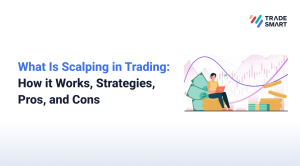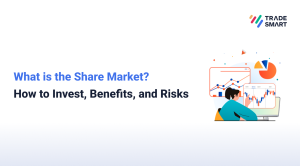
The stock market attracts traders not only for the chance to make money but also because there are so many different ways to get involved. Whether the quick decision-making of day trading is up your alley or you prefer the slower strategy of long-term investments, learning about how many types of trading exist is key. This starting point is crucial for anyone looking to become smarter about finances.
Our guide is here to shed light on the different types of trading, to help beginners make choices that are right for them. By understanding these methods, from speedy intraday trading to more deliberate position trading, investors can match their strategies with what they’re comfortable with and their financial aims. This not only helps investors make better decisions but also increases their chances of having a stable financial future. This knowledge also gives investors the power to use the stock market’s options to their benefit, making a personalised way to financial health and freedom.
The 6 Main Types of Trading in the Stock Market
Each type of trading comes with its strategies, risk levels, and time commitments. Traders have a variety of methods to explore that best fit their financial goals and lifestyle preferences, such as:
Intraday Trading
Intraday/Day trading is a strategy where traders buy and sell securities within the same trading day, aiming to profit from short-term price movements. This approach requires a significant time commitment, as traders need to monitor the markets and make quick decisions. Day traders often rely on technical analysis and real-time news to make trades. The main advantage of intraday trading is the potential for quick profits, but it comes with high risk and volatility. It’s suited for individuals who can dedicate the full trading day to this activity, have a considerable risk tolerance, and possess a strong grasp of market analysis.
Swing Trading
This is a strategy aimed at capturing short- to medium-term gains in a stock (or any financial instrument) over a few days to several weeks. Swing traders primarily use technical analysis due to its short-term nature, looking for patterns or trends that suggest future price movement.
Unlike day traders, swing traders are less concerned with the minute-to-minute fluctuations of a stock and more focused on identifying the momentum in the market. The benefits include not needing to monitor positions every minute of the trading day, which makes it more manageable for those with less time to dedicate.
Position Trading
This is a long-term trading strategy. Traders hold positions for weeks, months, or even years, to profit from the asset’s long-term trends. This approach relies more on fundamental analysis compared to day or swing trading, with traders often considering macroeconomic factors, company performance, and industry trends in their decision-making process.
Position traders are less affected by short-term market volatility and do not need to monitor their trades daily. The main advantage is the potential for significant returns if the long-term trend prediction is correct, but it requires thorough research and a solid grasp of market drivers.
Scalping
This is one of the quickest trading strategies, involving frequent and very short-term trades to capture small price gaps created by order flows or spreads. Scalpers aim to make numerous small profits, which can add up to substantial amounts by the end of the trading day. This strategy demands constant market monitoring, quick decision-making, and an ability to react instantly to market movements.
Scalping is suited for individuals who can dedicate their entire focus to the markets during trading hours and who possess the discipline to quickly move in and out of trades. The advantages include opportunities for consistent daily profits and limited exposure to overnight market risks. However, it requires an excellent understanding of market mechanics and comes with a high level of stress due to its fast-paced nature.
Options Trading
This involves buying and selling options contracts that give the holder the right, but not the obligation, to buy (call) or sell (put) a security at a predetermined price before a specific date. This type of trading can be used for speculation, leveraging small amounts of capital to potentially earn significant profits, or for hedging, protecting against losses in other investments.
Options trading offers flexibility with strategies that can profit from market movements in any direction. However, it requires a thorough understanding of options theory, the ability to forecast future price movements accurately, and knowledge of the specific risks associated with options contracts. The complexity and risk of options trading make it suitable for more experienced traders who are willing to spend the time to learn about the nuances of options markets.
Algorithmic Trading
This type of trading involves using computer programs to execute trades at speeds and volumes that humans cannot match. Algorithmic trading is used by institutional investors and advanced traders to slice orders, manage risks, and execute strategies efficiently. This type of trading minimises the impact of human emotions on trading decisions, allows for backtesting strategies on historical data, and can exploit market inefficiencies.
However, it requires a deep understanding of both trading strategies and computer programming, as well as access to sophisticated technology and data. The benefits include high efficiency and precision, but the approach may be less accessible to retail traders without the necessary resources and expertise.
What Are the Most Popular Types of Trading in India?
Popular trading types in India include intraday trading, where traders capitalize on short-term market movements by buying and selling within the same day. This method demands constant market vigilance and is popular among those who can dedicate significant time to trading.
Swing trading, with its focus on capturing gains over a few days to weeks, offers a less intense option for those who cannot monitor the markets every moment.
Position trading and investing, which focus on long-term growth, align well with the patient investor looking for gradual wealth accumulation.
With the rise of technology, algorithmic trading has gained traction, appealing to tech-savvy traders aiming for efficiency and precision.
Each style has its place in India’s dynamic market, offering individuals the flexibility to choose a trading approach that best matches their investment goals, time availability, and risk tolerance.
Which Type of Trading Is Best for Beginners?
For beginners, the best type of trading often depends on individual preferences, time availability, and risk tolerance, but many experts recommend starting with swing trading or long-term investing.
Swing trading allows beginners to tap into the market’s potential without the intense pressure and rapid decision-making required in day trading. It offers a more manageable pace, where trades last from several days to a few weeks, giving new traders more time to analyse and understand market movements and trends. This approach requires less constant market monitoring, reducing the stress and time commitment while still providing a hands-on experience with reading charts and executing trades.
On the other hand, long-term investing focuses on building wealth gradually over months or years, relying on fundamental analysis to pick stocks or other assets with strong growth potential. It’s less affected by short-term market volatility, making it a safer option for those new to the markets. Long-term investing helps inculcate patience and discipline in beginners, teaching them to look beyond temporary market fluctuations and focus on overall growth trends.
Conclusion
Knowing about the different types of trading in India will give you a confidence boost to dive into the world of trading. Remember, it’s important to never stop learning, manage your risks wisely, and find a trading style that feels right for you and your goals. You don’t need to go at it alone – join trading groups, find a mentor, and always work on getting better at your strategies are key moves on your road to success. It’s all about taking those steps, one at a time, to build up your trading game.
Starting this trading journey? Consider teaming up with TradeSmart. Backed by over 2 decades of experience in the stock markets of NSE/BSE, we can equip you with the essential tools and advice to excel in your trading journey.
Disclaimer: This article is for information purposes only and should not be considered as stock recommendation or advice to buy or sell shares of any company. Investing in the stock market can be risky. It is therefore advisable to research well or consult an investment advisor before investing in shares, derivatives or any other such financial instruments traded on the exchanges.
FAQs
What are the different types of trading in the stock market?
In the stock market, different trading styles include day trading, for quick, same-day trades; swing trading, holding stocks for days to weeks; position trading, for long-term investment; scalping, for rapid, short-term profits; and options trading, involving contracts for future transactions.
Which is the best type of trading?
The best type of trading in India depends on your time availability, capital, risk tolerance, and investment goals. Day trading suits those who can monitor the market full-time, swing trading is for those with a bit more patience, and position trading is best for those with a long-term outlook. Scalping requires constant attention and quick decision-making.
Which type of trading is safe?
No trading is entirely safe, as all trading involves some risk. However, long-term investing is generally considered safer than active trading strategies like day trading or scalping due to less exposure to short-term market volatility.
How do I start trading?
To start your trading journey, begin by thoroughly educating yourself about the stock market’s fundamentals and the array of trading strategies available, to understand where you might fit in. Clearly define your financial objectives, choose a reputable brokerage, and open an account. Initiate your trading experience cautiously with a modest sum of capital. Before diving into live markets, hone your skills and test your strategies using a demo account, which simulates real trading without the financial risk, ensuring you’re well-prepared before you commit to trading with actual funds.
Which trading is low risk?
Long-term investing and some forms of swing trading are considered lower risk compared to other trading styles. They involve less frequent trades and a greater focus on fundamental analysis, which can provide more stability and lower risk over time.
Is trading a risky career?
Yes, trading can be a risky career choice. It involves uncertainty and the potential for financial loss, especially in markets that are volatile or unpredictable. Traders must be equipped to handle the stress of market fluctuations and the possibility of losing their investment. Risk management skills and the ability to adapt to changing markets are essential for anyone considering a career in trading.













